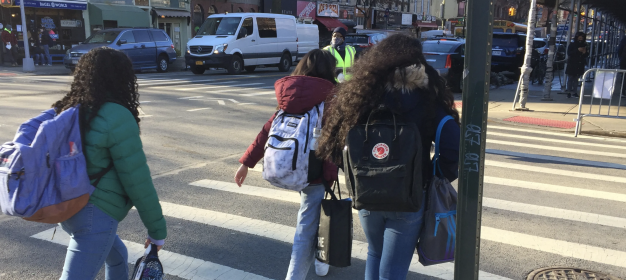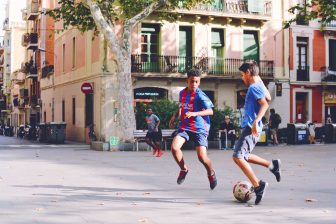
Low stamina and school avoidance: For tweens, this year is unusually turbulent
After two COVID years, students are ‘traumatized by many of the normal routines of a school day.’
In over a decade of teaching middle school, predominantly in sixth grade in Manhattan, I’ve ushered hundreds of tweens into my classroom. Sixth grade is a pivotal year. Students change from tumbleweed children into angsty teens as September slips into June.
They ride into the year eager and clumsy, ask questions they already know the answer to, beam in response to the simplest praise, and forget basic routines like how to staple an assignment together. They are excitable, hard to settle down, and need countless reminders to stop chatting, writes Stefanie Goldenberg, Chalkbeat New York
We, teachers, know these things. This is a roll up your sleeves, turn on your elbow grease, exert your creative electricity type of job. But this year is different. COVID changed the playing field, and there are no concrete suggestions for how to heal their social wounds and compensate for gaps in their learning. Teachers have been tasked with figuring it all out.
Courtesy photoStefanie Goldenberg
As for me, I’m experiencing the constant sensation of breathlessness. I am shouting through the layers of my KN95 mask in an overcrowded stairwell, asking students to put their cell phones away. Dozens of feet thunder past me towards the exit. They seem not to hear my muffled words. They are unaware or unfazed by our school’s cell phone policy. I stop and stare as a girl snaps a selfie in the hallway before returning to class.
These sixth graders, new to the building, were mere fourth graders when schools shut down early in the pandemic. Many are new smartphone users, overcome by the novelty, unaware of the social responsibility and burden it will present in their lives.
A school and clinical psychologist, Dr. Jessica Macklin, who works for a district on Long Island, informed me that she’s seeing a lot of school avoidance. She must go out to the parking lot many mornings and coax the children out of their parents’ car and into the building.
“Many kids just want to sit in my office,” she told me. “Last year, they sat in one class, six feet apart — even for lunch — for the entire day. This year, they’re switching classrooms with hundreds of other kids in the hallway. They have to put their belongings in lockers and are traumatized by many of the normal routines of a school day.”
I am seeing much of the same. In my sixth grade classroom, the social worker’s office is the most popular destination in the building. Everyone wants a turn to be soothed.
My students have returned with unprecedentedly low stamina. Whereas last year, during remote learning, they were able to use the bathroom or grab a snack at will, this year, they are confined to their seats for long stretches of time. One girl in my class rotates every 20 minutes between needing to go to the nurse and the bathroom. When I point out her excessive absence from the room, she quivers and insists that I’m infringing upon her rights. In previous years, I wouldn’t have stood for this. However, I learned from her mother that last year was a demoralizing experience for her. I dig deep for empathy, and I question my judgment in sending her out of the classroom each time she asks.
We are not back to normal, not by any stretch of the imagination.
There is almost no such thing as social distance for 10-, 11-, and 12-year-olds left to their own devices. Once the recess bell rings, they clamor for one another, hungry for connections. My principal reminded the staff in an email last year that for middle school students, socializing is like breathing. They have been traumatized by their social quarantine, with ramifications still yet to be fully seen. They are now bouncing back and forging bonds with fervor. While they wear their masks and distance in the classroom, this dissipates the moment they exit the room. Hallways are packed with students swinging on one another’s limbs, telling secrets at close proximities, and walking side-by-side as if bound by glue.
At any given time, I have three to seven students who have non-academic needs to address. First, there are the requests to visit the social worker or guidance counselor each time a social peril arises. The next tactic is the drained water bottle. Their hands fly in the air to refill water bottles constantly. More water equals greater bathroom usage. Then we have the multitudes of the wounded who need nurse attention. They are injured in gym class — pelted by dodgeballs, as if they haven’t been on a court, ever. They have headaches, nausea, cuts, bruises, and sprains at alarming rates.
Meanwhile, the city has rolled out a series of standardized assessments, called the MAP Growth, to break down students’ areas of strength for tailoring instruction. These are to be implemented at the beginning, middle, and end of the year, eating up valuable instruction time. Moreover, the annual state tests, optional last year, are scheduled for March and April 2022. Teachers are evaluated based on the results, and students will remain accountable for the high school admissions process. We all want to return to the pre-pandemic momentum, but it’s unclear whether those outside the classroom know how complex a build-back we face.
And let’s not forget, while we are juggling to meet these unprecedented demands, we are masked. I am grateful for the safety my mask provides. I won’t take it off until epidemiologists condone it. However, we are teaching, conducting meetings, and speaking with parents — for seven to eight hours a day — underneath our masks. But the worst part of all is that this mask conceals my greatest teaching tool: my teaching faces. My enthusiastic face, my delighted face, my disappointed face, my feigning ignorance to compel student-thinking face.
So much of teaching is garnering enthusiasm, relaying a passion for the subject matter. So I find myself gesticulating like my Yiddish-speaking Aunt Muriel. Each time I have to cut through a room of noisy chatter, to manage and correct behavior, to get down on eye-level with a troubled student, to quiet a noisy hallway, it takes three times the effort to project my voice. I often feel dizzy, as I can’t see peripherally or inhale deeply enough.
The message that preceded this school year was about the learning gaps we were to encounter and the social-emotional skills we ought to prioritize. The way forward is slow and long. We must pause. We must continually regroup. We must catch our breath. This is not business as usual. We are not back to normal, not by any stretch of the imagination.
While middle school feels like a particularly rocky boat to be in at the moment, teachers from pre-K to high school feel the turbulence. The fact is that my students have slid into their tweenage selves with huge gaps between what they know and what they should know. So while they are looking for ways to leave the classroom, I must remind them why it’s imperative to stay.
Stefanie Goldenberg has been an educator in the New York City public school system for the past 15 years. She lives in Manhattan with her husband and two young children. Her most recent publication was in Teachers & Writers Magazine.
First published on Chalkbeat, a non-profit news site covering educational change in public schools in the USA.
Sign up for their newsletters at ckbe.at/newsletters





